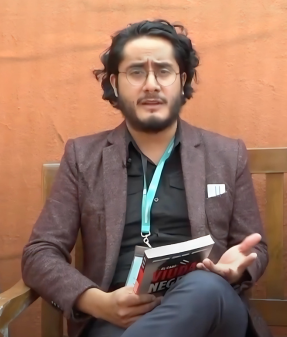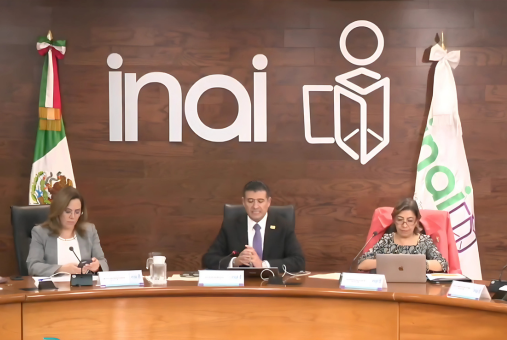Mexican journalist Zedryk Raziel realized the importance of his country’s public information agency when he attended an investigative journalism conference in Rio de Janeiro two years ago. Raziel presented an investigation he conducted with two colleagues about a massive money-laundering scheme within the government of former President Enrique Peña Nieto, a case known as “Black Widow.”
The most common question he received from colleagues at the Latin American Conference on Investigative Journalism about his investigation for the digital outlet Animal Político was how he obtained a vast amount of public information about contracts, bank transfers and government deposits to shell companies that supported the investigation, which later became a book.
“They told me they didn’t understand it, that they depended heavily on the goodwill of their sources,” Raziel told LatAm Journalism Review (LJR). “They had to build sources outside the institutions to get certain documents, while I, as a Mexican, have free access to them.”

Journalist Zedryk Raziel obtained the documents that supported his investigation into a money laundering case through Mexico's access to information system. (Photo: Screenshot from Penguin Random House YouTube channel).
Raziel, who now works in the Mexico bureau of the newspaper El País, said Mexico’s National Transparency System has been essential for his work documenting corruption and monitoring government efficiency.
“The National Transparency Platform offers many of these official numbers that institutions must—because they are legally obligated—make public. It has helped me in many ways,” he said.
That light to cast transparency on the Mexican government may soon go out. On Nov. 20, the Chamber of Deputies approved a reform bill to dismantle the National Institute for Transparency, Access to Information, and Protection of Personal Data, or INAI for its initials in Spanish. The initiative is part of a constitutional reform package sent by former President Andrés Manuel López Obrador just months before he left office this year. To be enacted, the reform bill still has to be reviewed by the Senate and, if necessary, signed into law by President Claudia Sheinbaum.
Raziel and many others see the imminent closure of the INAI as a regression into an era of obscure governance. The reform bill does not make clear what will happen to citizens’ right to access information if the institute, which operates independently from any other government agency, disappears.
The proposal suggests dissolving the INAI and transferring its responsibilities to institutions under the authority of the executive, legislative and judicial branches, according to the document submitted by López Obrador. It does not offer an alternative plan to guarantee citizens’ right to access information.
“Everything is being done hastily, without proper planning, with no vision beyond the disappearance of the INAI,” Leopoldo Maldonado, regional director of Article 19 for Mexico and Central America, told LJR. “There’s no concrete proposal on the table for secondary law reforms, for the laws derived from the Constitution itself, and that obviously creates enormous uncertainty regarding access to information.”
Journalists and transparency experts in Mexico agree the future of the right to access information in the country is currently riddled with uncertainty. However, they foresee greater obscurity and more obstacles to hold power accountable.
Among the main uncertainties is what will happen to the National Transparency Platform, the digital system managed by INAI that allows citizens to easily access public information from more than 8,000 government institutions.
“Today, a journalist who wants information simply goes to the platform and submits a request, just like any citizen,” Fernando Nieto, a professor specializing in government and public administration at El Colegio de México and a former member of INAI’s Advisory Council, told LJR. “It’s unclear who will manage this platform because it’s going to become a decentralized system where the executive does its part, the legislative does its part, and so on.”
The platform also enables the filing of appeals if requested information is denied or provided incompletely. The reform initiative leaves unanswered how appeal mechanisms will function if INAI disappears. According to Nieto, it’s likely that legal actions may be required to file appeals.

López Obrador's initiative contemplates dismantling INAI and transferring its responsibilities to institutions of the Executive, Legislative and Judicial branches. (Photo: Screenshot from INAI's YouTube channel).
This, Nieto added, would complicate processes that are currently relatively agile and could even impose new costs on citizens.
“If I disagree with a decision, I’ll have to invest much more time and resources to overturn it and obtain information, particularly in more sensitive cases,” Nieto said. “These processes will become much longer and more uncertain in terms of their outcomes.”
The transfer of functions from an independent body to institutions under the oversight of government branches also raises concerns about potential conflicts of interest.
Nieto explained that, when the changes to the law are enacted, a journalist requesting information from a government ministry, for example, would have to appeal to another ministry within the same branch of government if their request is denied.
“In this new scenario, the executive branch that denied my request would also be the executive branch responsible for ‘admonishing’ itself to release the information,” Nieto said. “In other words, it would act as both judge and jury.”
López Obrador’s initiative proposes transferring oversight of the right to access information related to the executive branch to what is now known as the Ministry of Anti-Corruption and Good Governance.
For journalist Zedryk Raziel, the idea of placing responsibility for guaranteeing access to information in the hands of the government itself, rather than an independent agency, is absurd.
“The notion that a government could guarantee its citizens that the government itself will act as a guarantor of access to information is ridiculous. The reasoning behind it is pathetic,” Raziel said.
When López Obrador announced his intent to dismantle the INAI, he described it as an expensive body that served “no purpose.” The former president worked to craft a narrative against autonomous agencies that were inconvenient for his administration, supposedly in favor of the austerity policies that defined his government, Maldonado said.
“It’s a narrative full of lies and disinformation, claiming that an oversight agency is too costly when it represents a minimal fraction of the federal budget,” Maldonado said. “President Sheinbaum continues that narrative, alleging that INAI hid information in cases like Odebrecht or other corruption scandals and severe human rights violations, which isn’t true.”
What is true, however, is that opacity increased under López Obrador. During his administration, the rate of negative responses to information requests rose compared to the previous administration, according to INAI data through 2023. Additionally, López Obrador issued executive orders to declare information about his government’s major infrastructure projects as matters of national security, shielding them from public scrutiny.
“That clearly signals intentions of opacity,” Maldonado said. “There are countless unresolved issues from the previous administration—billions of pesos unaccounted for in various social projects and institutions. The destruction of INAI and the opacity that will result from it is, of course, very convenient.”
The news report "The White House of Enrique Peña Nieto," published in 2014 by Aristegui Noticias, marked a milestone in investigative journalism as a tool for promoting accountability. The investigation, which won the 2015 Gabo Award for Coverage, exposed the close and indisputable links between then-President Peña Nieto and a state contractor.
One of the investigation’s key pieces of evidence was obtained through an information access request to the Presidential General Staff. The information provided by the agency, responsible for the president’s security, confirmed that Peña Nieto’s family lived in a $7 million mansion built by the contractor.
For journalist Rafael Cabrera, one of the reporters on the story, the investigation is clear proof that Mexico’s transparency system has been effective as a means of accountability.
“We relied heavily on the transparency system, and it worked. It worked at every level, from local to federal governments,” Cabrera told LJR. “In some cases, agencies requested extensions because we were asking for a lot of information, but none denied it or forced us to fight for it.”

Journalist Rafael Cabrera said he became an expert in the use of Mexico's transparency platform and that he submits about 10 requests for access to information per day. (Photo: Courtesy Rafael Cabrera)
Cabrera noted that Mexico’s transparency system allows journalists to access raw, unfiltered information from public agencies without needing to depend on sources or leaks from within institutions.
“The important thing about INAI is that it’s autonomous and independent from the branches of power,” Cabrera said. “Now, it will become a system subject to that power. This means the government itself will decide what information to provide and whether it complies, which sounds ripe for bias.”
Still, Cabrera acknowledged that Mexico’s transparency system isn’t perfect and has many areas for improvement. According to him, INAI is influenced by political parties and the government in power, and it is not particularly close to society.
“It became a niche tool—something for just a few people,” Cabrera said. “In that sense, it had room for improvement. Of course, no one can claim ‘INAI is perfect, untouchable, and always acted with good intentions.’ Good intentions, maybe. But its execution is questionable.”
Journalist Zedryk Raziel agreed the INAI could improve in its ability to penalize agencies that repeatedly refuse to provide information. INAI’s authority is limited to imposing fines and issuing recommendations, often forcing requesters to escalate matters to judicial bodies, where processes are long and uncertain.
“INAI can only impose a fine on the official who refuses to deliver the information, but that’s it,” Raziel said. “There’s no prosecution of these offenses, and if you want to escalate the matter, you have to take it yourself to the administrative courts.”
Cabrera said that the implementation of the transparency system and its evolution over two decades elevated the standard of Mexican journalism, not only in terms of accountability but also in areas like the development of data journalism and the documentation of violence.
He explained that learning to use the transparency platform involved building collective knowledge, where journalists, activists and lawyers supported one another.
“We, as journalists, had to study and learn military terms, legal terminology, and other highly technical concepts. It required tremendous specialization. And that’s what we’re going to lose now.”
If the INAI is dissolved, Raziel and Maldonado fear that journalists will have to revert to strategies from decades past.
“Perhaps, like my colleagues in other countries, I’ll have to go back to the old ways—cultivating sources in public service just to access a fraction of the information held by these obligated entities,” said Raziel.
Cabrera, however, expressed confidence that Mexican journalists would find new ways to continue holding power accountable. For him, the information access system is just one of many tools available to journalism.
“Are we going to sit back and say, ‘I won’t do journalism anymore because I no longer have access to information through the transparency platform’? That would be a defeat,” he said. “This presents a challenge for journalists. Things are changing, so how will we find new sources and documents to keep doing what we aim to do? I don’t think anyone wants to lower the bar.”
Cabrera and Raziel agreed that the potential changes will undoubtedly present yet another obstacle for journalists in a country where the press already faces significant challenges such as violence, stigmatization and government attacks on credibility. However, they emphasized that access to information is a human right, and its violation must have consequences.
“I think we journalists haven’t organized enough to try to stop this reform—or, if that’s not possible, at least protect ourselves,” Raziel said. “The right to access public information is something I took for granted, and it’s shocking and deeply disappointing to see a government daring to go this far.”